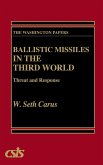This is the most up-to-the minute survey of the vital subject of sea-launched cruise missiles (SLCMs) to appear in ten years. It systematically analyzes the technological promises and weaknesses of SLCMs, especially conventionally armed, land-attack versions, explaining sophisticated technologies in language accessible to the general reader. Eric H. Arnett presents a cogent assessment of the crux of the SLCM issue for U.S. security, examining the coastal nation concept of the U.S. defensive position and investigating whether technology can adequately compensate for geography as Tomahawks and their Soviet counterparts give way to more advanced progeny. Arnett weighs the trade-offs in a frank discussion of the technologies and missions envisioned for current and future SLCMs. This well-researched, authoritative study evaluates both U.S. and Soviet SLCM arsenals, examines the role of arms control and unilateral initiatives in managing the dangers of SLCMs, and critically assesses the claims made for the Tomahawk conventionally armed cruise missile. The relevance of a changing international scene and domestic fiscal chaos to SLCM issues is fully appraised. The book's eight chapters lead the reader through all aspects of this complex field with admirable lucidity. Early chapters describe missions envisioned for U.S. conventionally armed SLCMs, and assess actual SLCM technology. Chapter 4 addresses the reciprocal problem of Soviet SLCMs, describing possible and likely roles of Soviet nuclear and conventionally armed SLCMs and the importance of offering responses. The increasingly important question of how SLCMs might be used in the developing world, both by and against U.S. forces and security partners is considered in Chapter 5--an especially relevant discussion in light of the apparent success of the Tomahawk SLCM in the 1991 war with Iraq. The next two chapters describe SLCM arms control as it has been practiced and discuss, from two vantage points, the roles of future arms-control and unilateral disarmament initiatives in addressing the disadvantages of SLCMs. Finally, the immediate implications of the previous chapters for policy practitioners are developed in a chapter that focuses on specific policy recommendations. This timely contribution is a reliable source of information on SLCMs for the interested public, the non-government arms control community, naval personnel, and members of both Congress and the administration.








